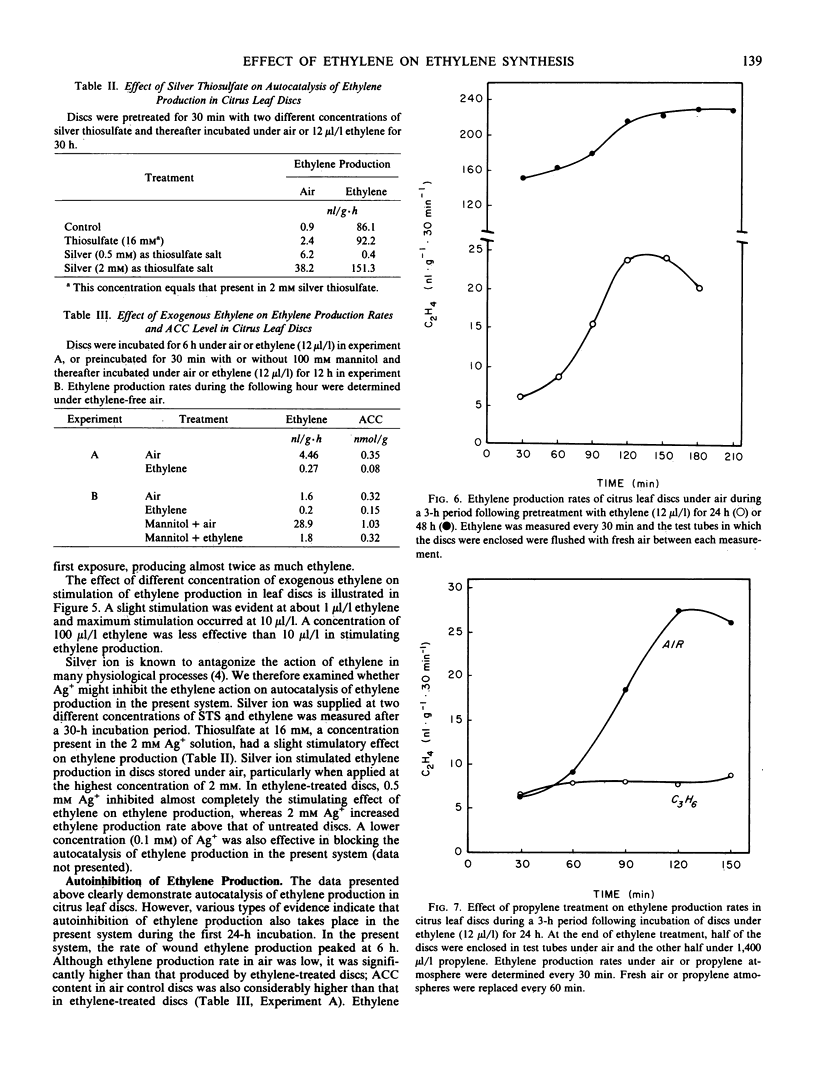Abstract
Exogenous ethylene stimulated ethylene production in intact citrus (Citrus sinensis L. Osbeck cv. “Washington Navel”) leaves and leaf discs following a 24-hour exposure. Studies with leaf discs showed that ethylene production decreased when ethylene was removed by aeration. The extent of stimulation was dependent upon the concentration of exogenous ethylene (1-10 microliters per liter). Silver ion blocked the autocatalytic effect of ethylene at concentrations of 0.5 millimolar and lower, but increased ethylene production at higher concentrations. The stimulating effect of ethylene resulted from the enhancement of both 1-aminocyclopropane-1-carboxylic acid (ACC) formation and the conversion of ACC to ethylene. Whereas autocatalysis was evident following 24 hours incubation, autoinhibition of wound- and mannitol-induced ethylene production was observed during the first 24-hour incubation. Ethylene treatment during this period resulted in a marked decrease in ACC levels and ethylene production rates. Furthermore, in leaf discs treated for 24 hours with ethylene, ethylene production rates increased greatly during the first 2 hours after removal of exogenous ethylene by aeration. This increase was eliminated if the discs were transferred to propylene instead of air, indicating that the autocatalytic effect of ethylene is counteracted by its autoinhibitory effect. It is suggested that autocatalysis involves increased synthesis of ACC synthase and the enzyme responsible for the conversion of ACC to ethylene, whereas autoinhibition involves suppression of the activity of these two enzymes.
Full text
PDF





Selected References
These references are in PubMed. This may not be the complete list of references from this article.
- Adams D. O., Yang S. F. Ethylene biosynthesis: Identification of 1-aminocyclopropane-1-carboxylic acid as an intermediate in the conversion of methionine to ethylene. Proc Natl Acad Sci U S A. 1979 Jan;76(1):170–174. doi: 10.1073/pnas.76.1.170. [DOI] [PMC free article] [PubMed] [Google Scholar]
- Aharoni N., Lieberman M. Ethylene as a regulator of senescence in tobacco leaf discs. Plant Physiol. 1979 Nov;64(5):801–804. doi: 10.1104/pp.64.5.801. [DOI] [PMC free article] [PubMed] [Google Scholar]
- BURG S. P., BURG E. A. ETHYLENE ACTION AND THE RIPENING OF FRUITS. Science. 1965 May 28;148(3674):1190–1196. doi: 10.1126/science.148.3674.1190. [DOI] [PubMed] [Google Scholar]
- Beyer E. M. A potent inhibitor of ethylene action in plants. Plant Physiol. 1976 Sep;58(3):268–271. doi: 10.1104/pp.58.3.268. [DOI] [PMC free article] [PubMed] [Google Scholar]
- Hoffman N. E., Yang S. F. Enhancement of wound-induced ethylene synthesis by ethylene in preclimacteric cantaloupe. Plant Physiol. 1982 Feb;69(2):317–322. doi: 10.1104/pp.69.2.317. [DOI] [PMC free article] [PubMed] [Google Scholar]
- Lizada M. C., Yang S. F. A simple and sensitive assay for 1-aminocyclopropane-1-carboxylic acid. Anal Biochem. 1979 Nov 15;100(1):140–145. doi: 10.1016/0003-2697(79)90123-4. [DOI] [PubMed] [Google Scholar]
- Mayak S., Vaadia Y., Dilley D. R. Regulation of Senescence in Carnation (Dianthus caryophyllus) by Ethylene: Mode of Action. Plant Physiol. 1977 Apr;59(4):591–593. doi: 10.1104/pp.59.4.591. [DOI] [PMC free article] [PubMed] [Google Scholar]
- Riov J., Yang S. F. Autoinhibition of Ethylene Production in Citrus Peel Discs : SUPPRESSION OF 1-AMINOCYCLOPROPANE-1-CARBOXYLIC ACID SYNTHESIS. Plant Physiol. 1982 Mar;69(3):687–690. doi: 10.1104/pp.69.3.687. [DOI] [PMC free article] [PubMed] [Google Scholar]
- Riov J., Yang S. F. Stimulation of ethylene production in citrus leaf discs by mannitol. Plant Physiol. 1982 Jul;70(1):142–146. doi: 10.1104/pp.70.1.142. [DOI] [PMC free article] [PubMed] [Google Scholar]
- Saltveit M. E., Dilley D. R. Rapidly Induced Wound Ethylene from Excised Segments of Etiolated Pisum sativum L., cv. Alaska: II. Oxygen and Temperature Dependency. Plant Physiol. 1978 Apr;61(4):675–679. doi: 10.1104/pp.61.4.675. [DOI] [PMC free article] [PubMed] [Google Scholar]
- Yu Y. B., Adams D. O., Yang S. F. 1-Aminocyclopropanecarboxylate synthase, a key enzyme in ethylene biosynthesis. Arch Biochem Biophys. 1979 Nov;198(1):280–286. doi: 10.1016/0003-9861(79)90420-x. [DOI] [PubMed] [Google Scholar]
- Zeroni M., Galil J. Autoinhibition of Ethylene Formation in Nonripening Stages of the Fruit of Sycomore Fig (Ficus sycomorus L.). Plant Physiol. 1976 Apr;57(4):647–650. doi: 10.1104/pp.57.4.647. [DOI] [PMC free article] [PubMed] [Google Scholar]


